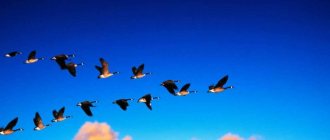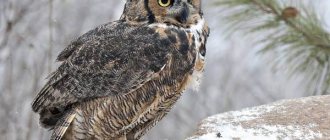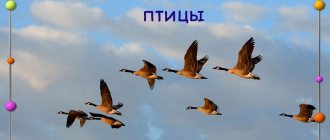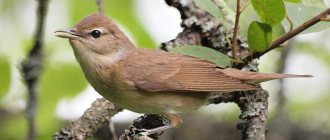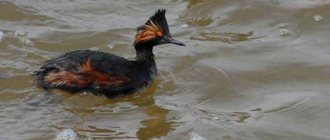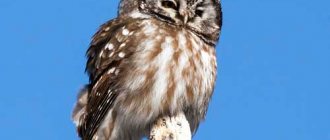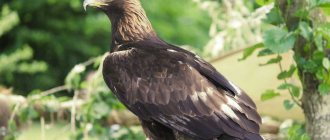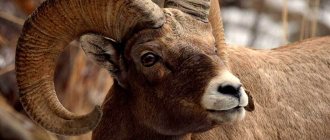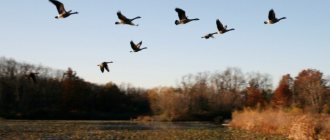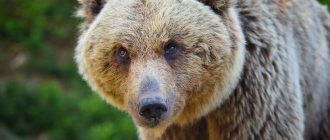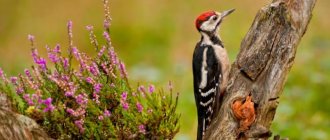A drop in temperature and the lack of usual food forces birds to leave their usual places of life in winter; for this reason, many species of birds are migratory.
The list of such birds is huge, but you need to clearly know which are migratory birds, which can be called conditionally migratory, and which are always sedentary.
Migratory birds:
- martin;
- lapwing;
- song thrush;
- robin;
- lark;
- flycatcher;
- finch;
- dawn;
- garden warbler;
- kingfisher;
- redstart;
- hoopoe;
- bittern;
- wagtail;
- oriole;
- nightingale;
- black-headed warbler;
- swan;
- goose;
- duck;
- rook;
- crane;
- capercaillie;
- grouse;
- pika;
- crossbill.
Pictures with names for children, which depict birds flying south in winter, most often represent cranes. But a huge number of birds leave their habitat, except for these birds, and they do not do this immediately, but each species at a certain time.
Features of migratory birds, their differences from wintering birds
The migratory birds depicted in the pictures do not stay in forests and cities as soon as the air begins to get colder. They can fly alone, they can gather in large groups - flocks, and fly to those regions where the climate is warmer.
Differences between migratory birds and wintering birds:
- With the onset of autumn, migratory individuals get ready to travel and fly away into the warmth;
- sedentary birds do not fly anywhere, remaining in the same place of residence;
- migratory birds cannot obtain food for themselves in winter; they do not have sufficient plumage to withstand the onset of cold weather;
- migratory birds nest in southern conditions.
Now you understand why changing weather forces some individuals to leave their permanent habitat and fly south.
A flock of seagulls flying south
Sensational discovery!
However, on May 21, 1822, a sensation spread around the world! Near Mecklenburg, Germany, an 80-centimeter arrow was found in the body of a dead stork, piercing the bird’s neck. The arrow was not from here and belonged to one of the African tribes. A desperate brave man with an arrow in his throat managed to overcome the entire migration route, returning home from the equatorial wintering grounds.
This story shed light on the mysterious disappearance of birds in winter. A stuffed specimen of the famous arrow stork can still be seen in the zoological collection of the University of Rostock.
Repeated reports of white storks with African arrows in their bodies helped make the discovery: European birds winter in equatorial Africa. However, ringing, which naturalists began to carry out since the 90s of the 19th century, made it possible to accurately determine the places where birds fly to for the winter.
Which migratory birds fly away earlier and which later?
Before considering the question of which birds are migratory, let us dwell on the timing in which birds fly into warm weather.
Departure dates for the south:
- First, birds fly away and use insects for food. Gradually, the insects begin to hide, so the birds have no choice but to look for food elsewhere, and they move south.
- As soon as the soil begins to freeze, birds begin to gather south and use seeds, grains of plants and trees for food.
- After the reservoirs are covered with a crust of ice, large waterfowl set off.
Birds strictly adhere to these deadlines, otherwise they may be left without food and die.
Migratory waterfowl
Types of migrations
Migration occurs during certain time periods or seasons of the year. Some representatives of the group of oviparous warm-blooded vertebrates are characterized by very irregular migration patterns.
Depending on the nature of seasonal migrations, all birds are included in the following categories:
- sedentary birds that adhere to a certain, usually relatively small, zone. Most species of sedentary birds live in conditions with seasonal changes that do not affect the availability of food resources (tropics and subtropics). In the territories of the temperate and arctic zones, the number of such birds is insignificant, and representatives of the group most often belong to synanthropes that live near humans: rock pigeon, house sparrow, hooded crow, jackdaw;
- semi-sedentary birds that, outside the active breeding season, move fairly short distances from the location of their nests: woodland, hazel grouse, black grouse, common bunting;
- birds that migrate long distances. This category includes land birds and birds of prey that move to tropical regions: brant goose, black-breasted and American shorebirds, long-toed shorebird;
- “nomadic” and short-distance migrating birds, moving outside the active breeding season from one place to another in search of food. Short migration is caused directly by unfavorable food and weather conditions, which are of a relatively regular nature: red-winged hornbill, weasel, lark, finch;
- invading and dispersing birds. The movement of such birds is due to a sharp decrease in the amount of food and unfavorable external factors that cause frequent invasion of birds into the territories of other areas: waxwing, spruce Shishkarev.
Best articles: Amazing and interesting facts about house flies
The timing of migration is strictly controlled and genetically coded, even in many sedentary bird species. The tendency to navigate and the ability to navigate throughout the entire migration period is determined by genetic information and learning.
Which birds arrive from the south first?
The very first to return from warm regions are rooks and starlings; these birds are the heralds of the onset of spring and warmth. At the end of March, wagtails, tits and ducks appear on the streets and in the forests.
Below you will find pictures of migratory birds for children with names.
The last to return from the south are seagulls, ducks, geese, and cranes. This is due to the fact that they eat numerous insects, small larvae, and feed on fruits and berries that are not yet found in early spring.
Starlings
Starlings go to warm countries with the onset of cold weather - in September-October. Sometimes their departure lasts until November. They migrate in flocks. They winter in northern Africa, Asia, and southern Europe.
Starlings live not only in birdhouses, but also in hollows, rock niches, and sometimes in the burrows of shore swallows. For most of us, these birds are familiar in black color with white spots on the wings. This is the common starling, famous for its singing. He imitates the songs of a nightingale, the cry of an owl and a cuckoo, the voice of an oriole and anything else.
But in nature there are other starlings that surprise with their appearance - the pink starling that lives in the south of Russia, the amethyst starling in African tropical forests, the soft beige Cambodian starling that lives in Indochina. And 7 other species, when looking at which, without knowing about these birds, you would not understand that these are starlings.
Starlings go to warm countries with the onset of cold weather. © Ulrike & Jörg
All migratory birds of Russia: with photos and names
In this section you will find pictures with the names of migratory birds and a brief description of them.
Whitebrow, a type of thrush
Belobrovik
Belobrovik prefers to live in coniferous and birch groves, and is often found in the tundra. This is an omnivorous bird; it feeds on earthworms, insects, mountain ash, and hawthorn.
A small representative of blackbirds migrates to the southern regions in winter and can reach Africa.
Shore swallow, shore swallow
Beregovushka
One of the varieties of swallow, listed in the Red Book. Likes to nest on sandy or clayey shores, in ditches and quarries. These birds do not fly to populated areas; only occasionally they can settle in the cracks of abandoned houses.
The bird flies to India and southeastern Africa for the winter. The shorebird flies away at the end of August - beginning of September, and returns back in mid-spring. Migration occurs in a flock; birds can cover up to two hundred kilometers in a day.
White stork
A pair of white storks in a nest
The stork is a migratory bird; as soon as summer comes to an end, it takes flight to get to warmer climes. First, young birds gather in flocks, a little later the old birds also set off on their journey. The wedge of storks flies, maintaining an altitude of two kilometers. Every night the birds stop to rest; during their flight, storks cover up to six to nine thousand kilometers.
Most often, storks fly to winter in Africa, Asia Minor, Spain, Kenya, and Somalia.
Woodcock
Woodcock
This large bird with short legs and a thin beak belongs to the category of migratory birds. Individuals go to winter in India, Afghanistan, northern Africa, Iran, and Ceylon.
Woodcocks begin to fly away in October, when the first frosts begin. During this period, woodcocks appear in places where they have not nested before, which indicates their readiness to migrate to warmer climes.
Godwit
Godwit
A migratory bird belonging to the snipe family. It is distinguished by its beautiful appearance and long legs. It settles in swamps, near reservoirs and lakes, and can nest in crops of perennial grasses and in low damp places.
Breeds in North America and Eurasia. This individual goes to winter in Australia, Africa, South America and Indonesia.
Wryneck
Whirlwind
When listing the names of migratory birds for children, do not forget to mention the whirligig. It is a close relative of woodpeckers, but, unlike them, it goes to warm countries for the winter. The bird feeds on small ants, larvae and pupae, fruits and berries.
The whirligig prefers to winter in Africa and southern Asia. She usually lives in hollows abandoned by woodpeckers.
Bluethroat
Bluethroat
This is a nomadic bird; it rarely leads a sedentary lifestyle. In normal times, it lives in Alaska, the European and Asian continents; only at the end of August do individuals fly to warmer climes; they do this alone.
It prefers to winter in North Africa, Iran, Southeast Asia, India or Southern China.
Common redstart
Redstart on a tree branch
This is a small bird, no larger than a sparrow. It is widespread in Europe, western and central Siberia, and Western Asia. This is one of the most beautiful birds that live in parks and city squares.
For the winter, the common redstart prefers to fly to Africa, the Arabian Peninsula, the south of the Sahara, the eastern part of Senegal, and Yemen.
Tiemaker
Ribbed
bird A bird from the Charadriiformes family, it is small in size and lives in the Arctic part of Eurasia. Usually settles on the shores of seas, lakes and rivers. It nests only in the warm season. For the winter it goes to warmer climes. But, with the onset of spring, it returns exactly to where it flew from.
mountain goose
Mountain geese in the meadow
This large, strong bird loves to live near a body of water (in floodplains, in wet meadows, near swamps and lakes), where it can obtain plant food.
The bar-headed goose is one of the last among other birds to leave for the winter. The exact time of departure depends on the place where it nests. For the winter, the goose flies to India, where it lives in the lowlands, in wetlands.
Rook
Rook
The rook is a well-known bird, with the arrival of which people judge the coming of spring. Usually these birds live close to human habitation, on flat ground. They build their nests on tall trees, roofs of houses, and power lines.
When cold weather sets in, rooks migrate to warmer regions. They can be removed from their homes in late October - early November. Some individuals prefer not to fly away for the winter at all, obtaining food for themselves in landfills.
Deryaba
Deryaba
A striking representative of the thrush family, considered the largest in Europe. The bird received such an interesting name for its ability to scream loudly when bad weather strikes. Deryaba settles in pine forests, ravines, and bushes.
The bird lives in southern and central Europe. For wintering, it flies to the southwestern regions of Europe, as well as to Central Asia.
Blackbird
Blackbird
A rather large, warm-blooded bird. The largest birds live in Russia and Ukraine. It feeds on insects, berries, seeds, and earthworms.
With the onset of cold weather, the blackbird changes its place of residence, flying to warmer climes.
Song thrush
Song Thrush
Let's continue the list of migratory birds with the Song Thrush. He doesn't like the cold, so when cold weather sets in he goes south
For the winter, it flies to North Africa, to the west and to the southern European regions. The song thrush returns back only with the onset of a thaw.
Field lark
Sky lark
Although this bird belongs to the group of migratory birds, it does not fly very far from the place where it made its nest. And the skylark returns quite early to its permanent place of residence.
Most often, these larks arrive in early March, when the snow has not yet melted from the ground. Moreover, the males appear first, occupying thawed patches warmed by the sun, only then do the females arrive.
Common Shrike
Common Shrike
This small bird lives in Europe, occupies the eastern part of Asia, up to the Yenisei and Altai Mountains. Birds cannot tolerate frost at all, therefore, as soon as the cold sets in, they take flight in September. Their goal is Africa, where they fly at night, devoting daytime to rest.
Robin
Robin
The Robin, also called the robin, is a migratory bird. It has colorful plumage and a friendly character. The bird lives on the coast of the North Sea, Africa, western Eurasia, and Russia. Especially often it nests in dense forests, thickets of hazel and alder.
With the onset of cold weather, the bird migrates to Africa and the Caucasus. She returns back in early April, when the streams begin to ring.
Wood Accentor
Wood Accentor
The secretive and cautious Wood Accentor loves to hide in bushes and thickets of grass, where it builds its nest. Mostly, the bird hides in spruce forests
During the winter it prefers to fly to warmer climes and returns back in the spring.
Finch
Chaffinch
A migratory songbird, it belongs to the finch family. If the climate in which the bird lives is acceptable to it, it may not fly anywhere for the winter. But most of the birds still fly south, to the central part of Europe, to the Mediterranean. Some spend the winter in the Caucasus, Kazakhstan or Central Asia.
Finches fly in large flocks that can accommodate up to one hundred thousand individuals. Their flight speed is fifty-five kilometers per hour. Every five to six hours they stop to rest. The finches return starting at the end of February. The males arrive first, followed by the females a week later.
Common oriole
Oriole on a tree
Oriole is a heat-loving bird; it leaves Russia in winter and returns back only at the very beginning of May. In normal times, birds live in parks, loving orchards, alleys where tall trees grow, and coastal thickets.
The bird flies away to spend the winter when its food supply is depleted. Most often, it heads towards African and Asian countries, to the central and southern parts of America.
Badger Warbler
Warbler-Badger
The Warbler-Badger is very common in Europe. It can be found in Poland, Ukraine, Latvia, Finland. It is found in the countries of Asia Minor, in Sri Lanka. Most often, the warbler lives in bushes and gardens, preferring to settle near water bodies.
This bird loves warmth very much, so it flies in advance to spend the winter in warm countries. Most often she flies to India. If we talk about birds living in Kazakhstan or Turkmenistan, they do not fly away for the winter.
Marsh warbler
Marsh warbler
Another representative of the passerine order. Found in temperate zones of Europe and western Asia. The bird goes to the countries of Southeast Asia for the winter.
Returns back in early May. First, the males return here, after some time the females also arrive.
Coot
Coot
Looking at photos of migratory birds with names, one cannot help but pay attention to the coot. This is a waterfowl that belongs to the rail family.
This is a migratory bird. Starting from September and ending in November, coots fly to warmer climes. They return in the opposite direction from March to May.
Buzzard
Buzzard
The buzzard is a bird that, despite its simple name, resembles a hawk in appearance. These birds love to soar in the air, looking for prey, and sometimes they sit in ambush.
When birds go to warm regions, they gather in numerous flocks. Most often they fly away in August - September and return back in April - May.
Common tern
Common Tern
This bird is a close relative of the gull. It lives on the shores and shallows of fresh water bodies, sand spits and islets. Birds place their nests on the territory of the American continent, as far as Texas and Florida. With the onset of winter, the common tern moves to the southern regions.
Common cuckoo
Common Cuckoo
The common cuckoo tends to wait out the winter in southern Africa, sometimes flying to the countries of the Arabian Peninsula. Even more rarely, this bird is sent to India or the southern provinces of China.
Some cuckoos living in tropical southern Africa do not fly anywhere for the winter, they only wander from place to place in search of food.
Klintukh
Klintukh
This bird belongs to the pigeon family. It lives in the forests of Asia, Europe, and is found almost everywhere. It cannot be found only in the middle part of the Ural Mountains, Western Siberia, and Scandinavia. Birds living in warm regions lead a sedentary lifestyle and can sometimes wander. Those that live in cold regions prefer to fly south for the winter.
Common nightjar
Common Nightjar
This is a bird that makes long migratory flights every year. Most often, birds living in Europe go to the eastern and southern parts of Africa for the winter. Only a few individuals move to the western part of Europe, abandoning long flights.
Forest Pipit
Forest Pipit
This is a bird from the wagtail family, it is slightly smaller than a sparrow. It lives throughout Eurasia, from the extreme western regions to the southern part of Yakutia. The pine pipit can be seen in forests or forest-steppes; it settles on the edges, in clearings, and in open forests.
For the winter, the bird flies to warmer regions. It returns back in April-May, when the period of active nesting begins.
Wren
Wren
A small bird that is half the size of a sparrow. The bird received this name for its love of living in nettle thickets. She looks for such bushes in deciduous, mixed and coniferous forests.
If the wren lives in the northern regions, then for the winter it necessarily flies to regions where it is warmer. The wren returns approximately when the first spring thawed patches appear on the roads.
Garden warbler
Garden Warbler
This is a small individual, with a long beak and inconspicuous plumage. Its habitat starts from Western Europe and ends in the eastern part of the Ural Mountains.
With the onset of cold weather, at the end of August, the bird flies to warmer climes. She may go to Spain or Portugal if the winter there is mild. Otherwise, it moves further to the southeastern part of the African continent. The garden warbler returns in May.
Landrail
Flying Crake
This bird is from the order Crane-like. Inhabits wet meadows and swamps. It can enter the taiga or climb the mountains, settles on the bolts of the taiga south, and sometimes chooses the hummocky steppes of Buryatia.
For the winter, the bird flies to the southeastern part of Africa. Autumn migrations take place very carefully, at night or in the evenings. Birds move in small groups or alone.
Mallard
Mallards
The list of migratory birds in Russia continues with the mallard. She may not fly anywhere for the winter, remaining to winter where she nested on rivers that do not freeze. But, most often, he strives to leave his home, going to the south of Europe or Africa. Seasonal migration begins with the onset of cold weather.
Tern
Pair of Arctic Terns
The Arctic Tern is an aggressive and cautious bird. It belongs to the gull family, is their close relative, but is slightly smaller in size. Flies away to winter in warm regions.
In 1966, a bird ringed in Wales was found in Australia. This indicates that the tern flew more than eighteen thousand kilometers.
Harrier
Flying Hen Harrier
This is a bird of prey that belongs to the hawk family. It lives in the northern hemisphere, in Eurasia and North America.
Harrier goes to spend the winter in the subtropical or temperate zone of Eurasia, where winters have little or no snow.
Barn swallow
Barn Swallow
This beauty with a forked tail and thin wings is considered one of the signs of the coming spring. This beautiful bird feels great in the clouds, it soars, and can instantly descend to the ground itself.
Swallows are found almost everywhere, with the exception of Antarctica and Australia. In Russia, the habitat of this bird reaches the Arctic Circle and the Caucasus. With the onset of cold weather, the barn swallow flies to warmer regions to return in the spring.
City swallow
Pair of City Swallows
A small bird that used to live in rocks and quarries, now moving to live in cities. This bird flies to Asia and Africa for the winter.
She arrives back no earlier than the end of April, beginning of May. With her arrival, they say that spring has come into its own.
Whooper swan
Whooper swans
This bird is widespread from Northern to Central Europe and East Asia. When it gets cold, the swan flies to the northern shores of the Mediterranean Sea, to the Caspian coast, to India, and China.
In normal times, the swan nests in quiet bodies of water, tundra, and forest-tundra near water. A large number of feathers and warm down allow the swan to postpone its flight to the south for a long time.
Robin
Robin on a tree
A strict and consistent individualist, not only living independently, but also flying to warmer climes for the winter. She has a developed instinct of ownership and can attack neighbors who encroach on her territory.
It has a characteristic singing that can be heard in the evening or at night.
Gray flycatcher
Gray Flycatcher
Gray Flycatcher is a migratory bird. She lives in open space, choosing sparse forests where there are cozy clearings and clearings. Can coexist with a person. Lives in the forests of Europe and Asia.
As soon as the cold weather sets in, the birds head south, most often to African countries.
Pied Flycatcher
Pied Flycatcher
The Pied Flycatcher differs from other species in its bright color, which contains only white and black colors. The bird has a black back, gray loin, black head with a white spot in the middle, and a white belly. The wings are brown-black, as is the tail.
This species of flycatcher goes to Africa for the winter.
Small flycatcher
Lesser Flycatcher
This bird is common in Eurasia. It is small in size, weighing up to eleven grams. The Sami of this species have a brown-gray back, the head, neck and chest are ash-gray, and they have a red stripe on the throat. There are white stripes along the sides of the tail and on the lower abdomen.
The small flycatcher goes to the southern part of Asia for wintering.
Reed bunting
Reed Bunting
Reed Bunting is distributed throughout Asia and Europe. This bird cannot be found only in the Far North, south and northeast Asia. If the bunting lives in the southern regions, then it leads a sedentary lifestyle, occasionally wandering from place to place.
If the bunting lives in the northern regions, then it flies to warmer regions for the winter.
Warbler
Willow Warbler
A small-sized individual whose weight ranges from eight to eleven grams. Most often found in Europe. The bird settles in bushes and in the foliage of trees. It can eat up to a third of its body weight in insects per day.
The willow warbler goes to African countries to spend the winter, preferring to settle in tropical forests.
Green warbler
Green warbler
This species of bird lives in the middle and southern part of the taiga, in the mixed forests of Central Europe, right up to the Pacific coast. You can meet the green warbler in coniferous forests located in the mountains of Central Asia.
The green warbler is a migratory bird; it flies to India for the winter.
Chiffchaff
Chiffchaff
This beauty lives in coniferous forests, most often in spruce forests. If it lives in a zone where deciduous forests are located, then it prefers small forests and can settle in forest swamps (which is typical for Belarus), in groves and gardens.
The bird flies away from its habitat with the onset of cold weather. From the territory of Eurasia it moves to the tropics of Africa.
Warbler rattle
Warbler (Birch Warbler)
This bird is also called the Birch Warbler. A larger number of birds of this species are common in the temperate and taiga zones of Europe. In the east, birds can be found up to the southern part of the Ural Mountains.
When it gets cold, the rattlefish easily migrates to tropical Africa.
Common kestrel
Kestrel
A species of bird of prey that has a long tail and equally long wings. Some species of this bird can lead a sedentary lifestyle, but the common kestrel prefers to fly to warmer climes for the winter.
If the kestrel lives in the northern regions of Europe and Asia, it migrates to the south of Europe or Africa. Birds living in Russia go to the eastern part of the Mediterranean coast for the winter.
Quail
Quail
This bird belongs to the pheasant family. She always stays alone; these birds do not form flocks. Only during seasonal migrations do quails form communities that are more or less connected.
Quails are not adapted to long flights. Only those birds that live in the northern regions can migrate south with the onset of cold weather.
Fieldfare
Field Thrush on a tree branch
Field Thrush belongs to the order of passerines. The bird loves to feast on rowan berries, which is why it got its name. It is large in size and moves along the ground by jumping.
Birds of this species lead a nomadic and sedentary lifestyle. In normal times they build nests in northern Europe. With the onset of winter, they go south, preferring Africa, the southern part of Europe and Asia Minor.
Common nightingale
Common Nightingale
A migratory bird that belongs to the order Passeriformes. When the first cold weather arrives, the nightingale goes to the northern part of Africa. Only in the spring does it return to the territory of its usual habitat.
The first birds arrive at the very beginning of April, but most return when the leaves bloom on the trees and bushes and the first insects appear.
Garden warbler
Garden Warbler
A secretive bird that can often be found in the Moscow region. It is difficult to see her, but you can hear her singing. All birds of this species that live in the temperate and northern zones must go for the winter.
They fly in the opposite direction in April, after which they begin nesting, incubating and raising chicks.
Gray Warbler
Gray Warbler
A bird with a large population. It lives in bushes in meadows, in river floodplains, on the edges of forests and in forest parks. When it gets cold outside, the bird prefers to go to warmer climes, choosing the African continent.
Whitethroat
Whitethroat Whitethroat
Whitethroat is common in central Europe. It has an average size with a body weight of up to twelve grams. A bird with brown plumage, it resembles the gray warbler, but is distinguished by a gray stripe on the top of its head.
Flies to Africa for the winter.
Warbler
Black-headed Warbler
The Black-headed Warbler is widespread throughout most of Europe, Asia Minor, and North Africa. Before flying south and before returning home, she begins to actively shed.
For the winter, the bird migrates to warm regions, most often the southern regions of Africa.
Martlet
Flying black swift
Black swifts live in Africa, Asia, and Europe. Swifts live in numerous colonies and are often encountered by city residents.
Despite the fact that the bird can live in southern territories, it chooses the mild climate of Europe and Asia for nesting.
Common cricket
The Common Cricket
is a slender bird with rufous legs and a wedge-shaped tail, weighing between fourteen and twenty grams.
The cricket is a migratory bird; if in normal times, during the nesting period, it lives in Asia and Europe, then it winters in hot countries. The bird makes long flights, trying to get to Africa or the southern part of Asia.
River cricket
Singing river cricket
Another species of bird from the order Passeriformes. It is large in size, brown with green plumage, dark beak and pink legs.
The bird lives over a wide area from Western Siberia to Central Europe. For the winter, the river cricket flies towards the tropical regions of Africa. He flies there in mid-July and in December he is already basking in the southern sun. Returns back to mid-spring.
Gray crane
Gray crane in the meadow
This bird can cover enormous distances. In the fall she goes south for the winter and returns back in the spring. For such a flight, she requires a sufficient amount of energy, so the gray crane begins preparations for migration in advance.
During the preparation process, the cranes choose a safe place where they prepare to fly. They gain strength and feed on mice, frogs, fish, and lizards.
White wagtail
White Wagtail
The White Wagtail is a small bird with a narrow beak, a black breast and a cap on its head. The lower part of her body is white, the upper part is gray. The bird moves along the ground at a run, quickly rearranging its legs. At low altitudes it stays well in the air.
When cold weather sets in, the bird can go into suspended animation, so it flies away for the winter in advance, trying to get to Africa or the southern part of Asia.
gray heron
Gray Heron
This is a large individual, the weight of which can reach two kilograms and the length of one meter. Gray herons are found in Eurasia, their distribution range extends to the middle taiga, with the exception of desert and highland areas.
If a bird lives in a warm region, it leads a sedentary lifestyle. If she lives where the winter is cold, she prefers to fly south for the winter.
Hobby
Flying Hobby
Hobby is a small bird that belongs to the genus of falcons. He is very active, fast and dexterous. The bird is most common in Eurasia.
The Hobby loves warmth, so with the onset of cold weather it migrates towards Africa and Asia.
Common lentils
Common Lentil
This is a bright bird with a melodious voice and beautiful plumage. In the wild, birds feed on seeds of trees and wild grasses. Lentils live in Eurasia and can be found in North America. She prefers to nest in open spaces, meadows and woodlands.
This is a typical nomadic bird that travels to southern Asian regions for the winter every August. She always flies through Siberia and returns back the same way.
Lapwing
Lapwing
Despite the fact that the lapwing, which lives in almost all known habitats, is a sedentary bird, individuals living in Russia are migratory. These lapwings prefer to winter on the islands of the Mediterranean basin. In addition, with the onset of cold weather, they fly to India and Asia Minor.
When the nesting period begins, lapwings settle in meadows, near swamps; if they live in the steppe zone, they choose the most moist areas.
Chernysh
Chernysh
This bird belongs to the order Charadriiformes. It has the size of a starling and lives in Eurasia. The bird has dark brown wings and back, a white belly, rump and chest with head. The white plumage of the scaup's tail can be seen far away, which is why it is nicknamed the white-tail.
With the onset of cold weather, the blackling prefers to fly to warmer climes.
Black-headed gull
Black-headed gull
This is an ordinary type of gull; the individual has a rounded head and a thin beak. The largest number of gulls is observed in Europe. In recent years, the population of individuals has been increasing in Asia and Canada.
Those birds that live in regions where the air temperature drops below -2 degrees in winter necessarily migrate to the coasts of the Mediterranean and Black Seas, the Indian and Pacific Oceans.
Water
Birds that prefer an aquatic habitat can be divided into river and sea birds. Their species diversity is quite large. However, these individuals are united by a love of swimming and dietary features: fish, small sea and river animals, and mollusks.
Waterfowl
River
The territory of Russia is rich in large and small rivers and lakes. Therefore, there are all the necessary conditions for the existence of river bird species. Valleys near reservoirs simultaneously serve as places for them to feed, nest, molt, rest, etc.
Kabansky reserve (Baikal)
Turpan
Belongs to the Anseriformes family. The length of the scoter reaches about 55 cm on average. Weight – a little more than 1 kg. The male and female are slightly different in size and color: males are black and females are brown. They feed on small river fish and shellfish. Turpan is an endangered species.
Turpan Interesting fact: scoters are able to dive 10 m deep into a body of water in search of food, and also spend about a minute under water.
Kingfisher
Kingfishers are no larger than sparrows, but are distinguished by their extremely bright colors and long beaks. They have a blue back and a reddish belly, and white feathers on the sides of their heads. For nesting, kingfishers dig holes on river cliffs. Sometimes, in search of food, a bird can fly at high speed just above the surface of the water.
Kingfisher
Sailor
Other names for the bird are alley, sauk. Belongs to Anseriformes. A characteristic feature of long-tailed ducks is a long, thin tail, characteristic of males. Both males and females regularly change color depending on the mating season, age, and time of year. Sailors are capable of diving deeply - up to 60 m.
Sailor
Loon
There are three species of loons in the Russian Federation: black-throated, red-throated and arctic. Black-throated is the most common. Body length is about 60-75 cm. Males weigh from 2.4 to 3.4 kg, and females are smaller. Loons change color depending on age and season.
Black-throated Loon
Whooper swan
Large graceful birds are up to 1.8 m in length and weigh about 10 kg. They prefer to make huge nests on lakes and in reeds. Swans are known for forming pairs for many years. Whoopers make loud noises both while swimming and in flight. They feed on plants and aquatic invertebrates.
Whooper swan
Marine
Many aquatic birds of Russia are found on the shores of the Okhotsk, Bering and other seas. Bird markets are formed here. These zones serve as a haven for both permanent and migratory inhabitants.
Bird market, Sea of Okhotsk
Hatchet
The hatchet belongs to the order Charadriiformes. The bird's body is about 40 cm long, weight - on average 700 g. The color is predominantly dark - black, brown, with the exception of white cheeks, an orange beak, yellow paws and long bright feathers behind the eyes. Birds unite in large colonies. They fly, swim and dive very well.
Toporok Interesting fact: several geographical features are named after Toporok. For example, Toporkovy Island (Kuril Islands) and Toporkov Island (Commander Islands).
Storm petrel
In the Russian Federation, the family of storm petrels is represented by two species – black and gray, which have much in common. Storm petrels are small in size, but have long wings. Birds move very quickly and from a distance they can be confused with swallows. The diet of storm petrels consists of small fish and plankton.
Storm petrel
White-tailed eagle
A large bird of prey that weighs 5 kg on average, and the body grows to almost 1 m in length. The color is brown with lighter plumage on the chest. The name of the species comes from the white tip of the tail. It is noteworthy that females are larger than males. Eagles feed on fish, so they live near bodies of water. The nests are built large - 1 m in height and 2 m in length. Listed in the Red Books (RF and international).
White-tailed eagle Interesting fact: the wingspan of a white-tailed eagle is up to 2.5 meters.
Cormorant
Of the Cormorant family, the most common species in the country is the Bering cormorant. It is distinguished by its black color with a metallic sheen. Females are usually larger (body up to 77 cm in length and weight about 1.5 kg). Cormorants have at least 6 color changes, which depend on the mating season.
Bering cormorant
Guillemot
There are two types of guillemots: thin-billed and thick-billed, which are very similar in appearance. They are common on the shores of the Far Eastern seas. The basis of the diet is fish. Murres have a conservative character, which can be seen in monogamy and a permanent nesting site. Guillemots are more adept at swimming than at staying in the air.
Guillemot
Deryaba
Refers to blackbirds. The species is also called the great gray. Not all individuals fly south. Those who dare to stay switch in winter from protein food in the form of larvae and insects to frozen berries.
Deryaba is shy. Therefore, it is difficult to see the bird in nature, even though it is feathered and the size of a dove. The deryaba is the largest of its kind.
Mistle Thrush
Common oriole
The front half of her body is yellow, and her wings, tail and part of her back are black. There are varieties with a dark mask and a bright tail. These live in Africa. Russian orioles fly there only for the winter. In snowy expanses, birds lack caterpillars, dragonflies, butterflies and other insects. They are the basis of the oriole’s diet.
The names of migratory birds , as can be seen, are often associated with external features or related to nutrition and lifestyle. The last option is relevant for the Orioles. They often settle in willow thickets along the banks of water bodies.
However, linguists and historians associate the name of the bird rather with the word “moisture”. The ancient Slavs considered the oriole a harbinger of rain.
The oriole is considered a harbinger of rain
Martin
Urban, field and coastal species nest in Russia. All are migratory. Birds in the fall fly away 9,000-12,000 kilometers from their native places. Among passerines, which include swallows, these are the longest flights.
On the fly, swallows manage to eat flies, sleep and even drink. For the latter, you have to descend over bodies of water, scooping up moisture with your beaks at lightning speed.
Over the course of their history, swallows have become symbols of hope, lightness, and even symbols of countries, for example, Estonia. This state issued a platinum coin with a face value of 100 crowns. There are 3 swallows depicted on the banknote. They grab the branch with their paws. Two birds sit quietly, and the third spreads its wings.
Warbler
A dense bird up to 11 centimeters long. There are 3 species living in Russia. They live everywhere except the Far East and Yakutia. In other territories, warblers make nest-huts.
Warblers have a pleasant voice timbre. Males especially love to sing during the nesting period. Trills are interspersed with whistling. You can listen to them at home. Warblers are easy to tame. In captivity, birds live up to 12 years. In nature, the age of birds is 2-3 years.
Listen to the voice of the warbler
Without being domesticated, the warbler flies south in mid-September. Birds return by early April.
